不同程度支气管肺发育不良早产儿的临床及影像学特点
支气管肺发育不良的影像诊断探析

I ma g i n g An a l y s i s o n B r o n c h o p u l mo n a r y D y s p l a s i a / C HE N Y o n g d / Me d i c a l I n n o v a i t o n o f C h i n a。2 0 1 4。1 1( 0 1) : 0 4 7 - 0 4 8
wi t h B PD c h e s t i ma g i n g d a t a c o n i f r me d b y c l i n i c a l a n d r a d i o g r a p h i c i n o u r h o s p i t a l we r e r e t r o s p e c t i v e l y na a ly z e d . Re s u l t :Ch e s t r a d i o g r a p h s o f 2 0 c a s e s
d o i :1 0 . 3 9 6 9 / j . i s s n . 1 6 7 4 — 4 9 8 5 . 2 0 1 4 . 0 1 . 0 2 3
支气 管肺发育 不 良 ( b r o n c h o p u l m o n a r y d y s p l a s i a , B P D) 况 。本组患 儿无死 亡病例 发生 。
【 K e y w o r d s 】B r o n e h o p u l m o n a r y d y s p l a s i a ; P r e m a t u r e I n f a n t ; X — r a y
医学影像-肺部先天性发育异常影像表现

4岁 右上叶支气管呈液气囊性密 度影,上叶肺组织过度充气。
n 支气管起源于气管隆突上气管壁的一种先天性畸形,起源于气 管的右肺上叶支气管。
n 临床症状:儿童可能出现喘息、反复肺炎等。 n 好发部位:通常为单侧性,多起自气管隆突上方气管右侧壁,
支气管先天性发育不良所致肺叶通气障碍
男,2个月,咳喘 1月余
n 节段支气管与中央支气管不相通,病因不明。可与肺隔离 症和支气管源性囊肿并存。
n 临床表现:大多数患者无,有症状的患者常表现为肺部反 复感染、呼吸困难、哮喘或慢性咳嗽。好发于女性患者 (男:女约1:2)。
n 好发部位:左上叶尖后段,其次为左下叶、右中叶。 n 典型影像学表现:分枝的管状团块,周围肺透亮度增高,
n 临床表现:反复呼吸道感染或无症状。症状以肺叶内型支 气管肺隔离症常见。肺叶外型支气管肺隔离症可无症状。
n 影像学诊断重点在于发现异常供应血管。
n 胚胎初期,在原肠及肺芽周围,有许多内脏毛细血管与脊 柱动脉相连。当肺组织发生脱离时这些相连的血管即逐渐 衰退吸收。
n 由于某种原因,发生血管残存时,就成为主动脉的异常分 支动脉,牵引一部分肺组织而形成隔离肺。该部肺组织与 正常支气管和肺动脉隔离开,由异常的动脉供应血液。
2013.10.15
n 最常见原因:支气管不完全阻塞。 n 畸形肺叶过度充气扩张,不伴有肺泡间隔破坏,且血管
结构发育正常,10%的病例合并先心病。 n 发病机制:
半数病例病因不明;可知因素包括: ①原发性支气管软骨发育不良或缺如; ②粘膜增生或管腔内粘液阻塞或管外异常血管或
肿瘤压迫等; ③少数病例系肺泡发育异常,肺泡数量增多所致
17例早产儿支气管肺发育不良的早期影像分析

ma i sain nc et f1 e nt ae fBP ftep e tr na t wt n ldan ss RE L S Amo gte nf tt si h s o 7 d f i cs so D o rmau eifns i f a ig oi. SU T e o i e h hi n m,5 c ssh d h ae a
虽 然早 产 儿 支 气 管肺 发 育 不 良的 诊 断 主要 依 据 临床 病 史 ,但 早 期 影 像 表 现 仍 具 有诊 断 价 值 ,胸 部 薄层 C T上 多发 囊状 影 是 诊 断
B D 的 重要 征 象 .连 续影 像 随 访 有 助 于该 病 的 早ቤተ መጻሕፍቲ ባይዱ 诊 断 P 关键 词 早 产 儿 支 气管肺 发 育不 良 影像 分 析 ‘
断为 B D的 1 P 7例 早产 儿 胸 部 影像 表 现 。结 果 1 7例 早 产 儿 中 ,胸 片 无 明 显异 常 5倒 ,继 发 于其 他胸 部 原发 疾 病 l 2例 胸 片 显示 两肺 野 模 糊 ,肺 透 光 度 减 低 5例 ;原 发病 病 程 持 续 2 4周 ,异 常征 象不 消失 ,且 连 续 照 片 变 化 不 明显 者 4例 。C - T主 要 表 现 为 肺 野 呈毛 玻 璃 密 度及 实 变 影 6例 ,肺 过 度 充 气 、 大 小 不 一 囊 状 透 亮影 1 0例 .粗 网格 状 影 呈 两肺 弥 漫性 分 布 4例 。 结 论
n p a e t b o ma ma e ; 1 a e e o d r y d v l p d s me o h r p ma y t o a i ie s s5 c e r s n e lu i g o a p r nl a n r l i g s y c s s s c n a l e eo e o t e r r r cc d s a e . a s p e e t d c o d n 2 i i h s
支气管肺发育不良
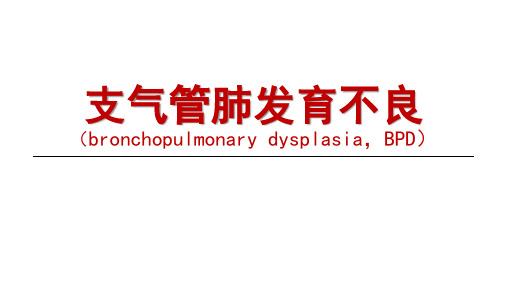
一、合理用氧
避免过高浓度氧以减少 PBD的发生危险,应尽 可能低流量氧气入。
在有血氧饱和度仪监测及血气分 析监测下,早产儿sapo2维持在 90%-95%即可。
为避免患儿产生氧依赖,可采取 低流量间断吸氧法,过度到停止 吸氧。
因吃奶用力较大,体能消耗大,早产儿肺部发育 不良,肺换气功能受阻而引起缺氧症状,吃奶时 予以低流量吸氧并采用间歇喂养法达到缓解缺氧 症状的目的,此期如能适应则能顺利停氧。
1、肺发育不成熟 2、急慢性肺损伤 3、损伤后异常修复
病因及发病机制
• 1、个体和基因易感性 种族和基因不同,BPD发病率和严重程度不同 家族中有哮喘或气道反应性疾病史者,BPD发病率增加
• 2、肺发育不成熟 BWT<1500g早产儿总BPD发生率为20%; BWT 750-1000g 早产儿BPD发生率上升至30%; BWT<750g者BPD 发生率高达50%。
性呼吸系统疾病的主要病因。
定义的演变
1967
Northway首 次报告RDS有 机械通气史生 后28d仍需用 氧伴有胸片异 常
1979
提出了BPD 临床诊断的
01 定义,强调
临床和影像 学表现,
1988
Shennan定义: 出生体重< 1500g的早产 儿在矫正胎龄 (PMA)36周仍 有氧依赖
2001
NICHD对辅助 用氧≥28天的 不同胎龄早产
03 儿进行了定义,
并做了严重程 度的分类
2018
NICHD细化了用氧 方式与BPD的分度, 强调了机械通气与 sBPD的关系,并 将日龄14 d至校正 胎龄36周之间因呼 吸衰竭死亡者归属 sBPD的诊断中
经典型“BPD”
NICHD:美国国家儿童健康与人类发育研究所
支气管肺发育不良PPT课件

治疗
营养支持 限制液体 氧疗法 肾上腺皮质激素
外源性肺表面活性物 质
现
随疾病的严重性而明显不同。 早期症状与原发疾病难以区别,常在机械
通气过程中出现呼吸机依赖或停氧困难超 过10~14天,提示可能已发生急性肺损伤。 小早产儿早期仅有轻度或无呼吸系统疾病, 仅需低浓度氧或无需用氧,而在生后数天 或数周后逐渐出现进行性呼吸困难、喘憋、 发绀、三凹征、肺部干湿啰音、呼吸功能 不全症状和体征以及氧依赖。
定义
支气管肺发育不良(bronchopulmonary dysplasia,BPD),又称新生儿慢性肺病, 是早产儿,尤其是小早产儿呼吸系统常见 疾病,具有独特的临床、影像学及组织学 特征。
最新定义
BPD是指任何氧依赖(>21%)超过28天的 新生儿,
如胎龄<32周,根据矫正胎龄36周或出院时 需FiO2分为: ①轻度:未用氧; ②中度: FiO2 <30%; ③重度: FiO2 ≥30%或需机械通气;
病程通常数月甚至数年之久。大部分病例 经过不同时期后可逐渐撤机或停氧;病程 中常因反复继发性呼吸道感染或症状性 PDA致心力衰竭而使病情加重甚至死亡。 严重肺损伤者由于进行性呼吸衰竭、肺动 脉高压而死亡。
胸部X线
经典BPD主要表现为肺充气过度、肺不张、 囊泡形成及间质气肿影,严重病例伴肺动 脉高压患者可显示肺动脉干影。
Northway根据BPD的病理过程将胸部X线分 为4期:
I期(1~3天):双肺野呈磨玻璃状改变, 与RDS的表现相同
II期(4~10天):双肺完全不透明
III期(11~30天):进入慢性期,双肺野密 度不均,可见线条状或斑片状阴影兼伴充 气透气小囊腔
IV期(1个月后):双肺野透亮区扩大成囊 泡状,伴两肺结构紊乱、有散在条状或斑 片状阴影及充气过度和肺不张
早产儿支气管肺发育不良新进展

命名与定义
但在2000 年6 月由美国国家儿童保健和人类发展研 究院(NICHD) , 美国国家心脏、肺和血液研究院及少 见疾病委员会共同举办的BPD 研讨会上, 一致通过采 用BPD 这一名称, 废用CLD, 以在流行病学、病因和 预后方面区别于婴儿期的其他慢性肺疾病。
同时制定了BPD 新定义, 并根据病情的严重性进行分 度( 见表1) 。肺部X 表现不应作为疾病严重性的评估 依据。
新旧BPD的比较
OLD BPD
大些的早产婴
可能产前未给予激素,产后 未给予表面活性物质,导致 严重的RDS
机械通气条件较高
生后1周内对氧的需求较高, 之后下降
容量损伤 氧中毒
炎症反应
机械通气 高吸入氧浓度 感染
水肿
PDA
BPD (急性肺损伤,炎症反应,细胞因子激活,血管损伤)源自病因 OLD BPD
NEW BPD
气压伤-肺气肿
肺发育未成熟
气道损伤-阻塞
感染:产前或围产期定殖感染,医院内感 染
氧中毒-肺水肿
炎症反应:IL-6,IL-8,IL-1β ,TNF-α,
促肺成熟
促肺损伤
感染/炎症与肺损伤
胎肺是炎症介质的靶器官;
成人肺对机械通气的炎症反应会因提前的促炎反应而放大;
脐血及新生儿早期血清中IL-1β,IL-6,IL-8,TNF-α升高与发展为 BPD密切相关;
解脲脲原体是最常见引起羊膜炎的病原体,胎儿定殖该菌发展 为BPD的为43%,而对照组为19%;
新生儿支气管肺发育不良的研究进展

新生儿支气管肺发育不良的研究进展摘要:早产儿感染、应用高浓度氧气以及机械通气容易引发支气管肺发育不良,新生儿支气管肺发育不良是早产儿常见的慢性肺部疾病。
由于当前医疗技术不断的发展和进步,新生儿重症监护技术研究也越来越深入,很多体重极低的患儿能够存活下来,导致了此病发病率越来越高。
本文主要就是针对新生儿支气管肺发育不良的治疗以及进展进行研究和介绍。
关键词:新生儿;支气管肺发育不良;研究进展支气管肺发育不良(BPD)又称新生儿慢性肺疾病(CLD),是早产儿,尤其是极低出生体重儿或超低出生体重儿呼吸系统常见疾病,具有独特的临床、影像学及组织学特征。
BPD是指任何氧依赖(FiO2>21%)超过28天的新生儿[1]。
该病病因不是很明确,常见于氧中毒、气压伤或容量伤以及感染或炎症等各种不利因素对发育不成熟的肺导致的损伤,以及损伤后肺组织异常修复。
其中,肺发育不成熟、急、慢性肺损伤、损伤后异常修复是引起BPD的3个关键环节。
主要见于胎龄小于28周,出生体重低于1000克的早产儿,胎龄越小、体重越低,发病率越高。
该病以肺实质性条纹和过度膨胀为其X线变化特征,临床表现为早产儿透明膜病后或迁延不愈或好转后又出现呼吸窘迫及缺氧,面色苍白、出汗、嗜睡、呕吐、干咳、气促、发绀、呼吸困难、生长迟缓或停滞及肺心病症状。
对于该病的治疗,目前尚无有效的治疗措施,需采取综合性治疗,包括营养支持、限制液体、呼吸支持、抗炎治疗等,平素注意预防受凉感冒,预防呼吸道的感染。
1.新生儿支气管肺发育不良的病因、临床症状1.1病因新生儿支气管肺发育不良由多种因素引起。
其本质是在遗传易感性的基础上,氧中毒、气压伤或者是容量伤以及感染或者炎症等各种不利因素对发育不成熟的肺造成的损伤以及损伤后肺组织异常修复。
其中肺发育不成熟,急性肺损伤,损伤后异常修复是引起支气管肺发育不良的三个关键因素。
具体来说:第一个就是个体和基因的易感性,临床以发现种族和基因不同,呼吸窘迫发病率和严重程度不同。
支气管肺发育不良的临床早期影像学分析
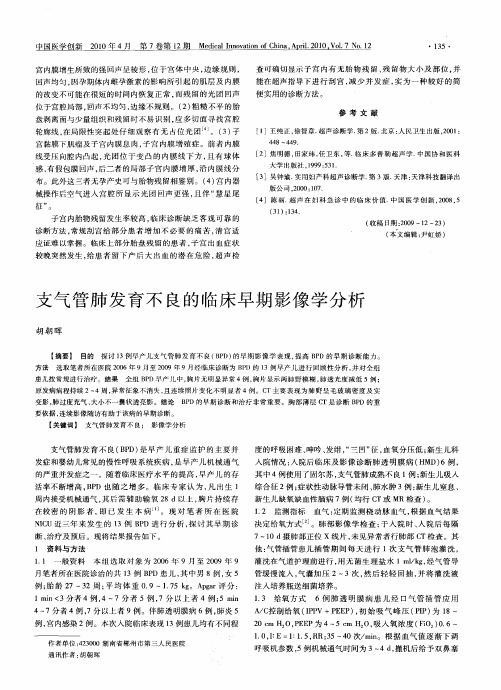
( 收稿 日期 :09—1 2 ) 20 2~ 3 ( 文 编辑 : 虹 娇 ) 本 尹
较晚突然发生 , 患者 留下产 后大 出血 的潜在危 险 , 声检 给 超
支 气 管 肺 发 育 不 良的 临床 早 期 影像 学 分 析
胡 朝 晖
【 摘要 】 目的
方法
探讨 1 例早产儿支气 管肺发育 不 良( P 的早 期影 像学表 现 , 高 B D的早 期诊断 能力 。 3 B D) 提 P
全组 B D早 产 儿 中 , 片无 明 显异 常 4例 , 片 显 示 两 肺 野 模 糊 , 透 光 度 减 低 5例 ; P 胸 胸 肺
选取笔者所在医院 2 0 0 6年 9月至 2 0 0 9年 9月经I 临床诊断为 B D的 1 早产 儿进行 回顾 性分析 , P 3例 并对 全组
患 儿 按 常 规 进 行 治疗 。 结 果
其 中 4例使用 了固尔苏 , 支气管肺成熟不 良 1例 ; 新生儿吸入
综合征 2例 ; 症状性 动脉导管未闭 、 肺水肿 3例 : 生儿 窒息 、 新 新生儿缺 氧缺 血性 脑病 7例 ( 均行 C T或 MR检查 ) 。 12 监测指标 . 血气 : 定期 监测桡 动脉血 气 , 据血气 结果 根
原 发 病 病 程 持 续 2~ 4周 , 常 征象 不 消失 , 连 续 照 片 变 化 不 明 显 者 4例 。C 异 且 T主 要 表 现 为 啼 野 呈 毛玻 璃 密 度 及 实
变影 , 肺过度充气 、 大小不一囊状透亮影。结论 要依据 , 连续影像 随访有 助于该病 的早期诊断 。
B D的早期诊 断和治疗非常重要 。胸 部薄层 C P T是诊断 B D的重 P
医学创新 2 1 4月 第 7 00年 卷箍 1 至
支气管肺发育不良 诊断标准

支气管肺发育不良诊断标准
支气管肺发育不良是一种罕见的先天性疾病,其诊断标准通常
包括以下几个方面:
1. 临床症状,患者可能出现反复呼吸道感染、呼吸困难、气促、咳嗽等症状。
这些症状可能会在婴儿期或儿童期就开始显现。
2. 影像学检查,支气管肺发育不良的诊断通常需要进行胸部X 光、CT扫描或MRI检查,以观察肺部和支气管的发育情况。
这些检
查可以显示肺部结构异常、支气管发育不全等特征。
3. 肺功能检查,通过肺功能检查可以评估患者的呼吸功能,包
括肺活量、气流速度、氧气摄取量等指标,从而帮助确认支气管肺
发育不良的诊断。
4. 遗传学检查,一些支气管肺发育不良可能与遗传因素有关,
因此遗传学检查可以帮助确认疾病的遗传基础。
5. 临床表现和其他相关检查,医生还会综合考虑患者的临床表现、家族史以及其他相关检查结果,综合判断是否符合支气管肺发
育不良的诊断标准。
需要指出的是,支气管肺发育不良是一种复杂的疾病,诊断需要综合考虑多个方面的信息。
因此,如果怀疑患有支气管肺发育不良,建议及时就医,由专业医生进行综合评估和诊断。
早产儿支气管肺发育不良研究进展

4
换部分尚未建立,故无气体交换功能。
原始肺泡期:指胎儿24周至新生儿阶段,又称终末囊泡期。此期原始肺泡数目较少,肺泡囊逐渐成熟,间质组织减少,毛细血管增生,肺泡气体交换能力及表面活性物质仍不足,至第34~35周才迅速上升。 肺泡发育期:指胎儿后期到生后8岁。肺泡的发育主要在生
后肺泡体积增加,主要由原始肺泡数目增加和每个原始肺泡体积的增大。
肾上腺糖皮质激素
的预防和治疗。
能,有助于撤离呼吸机,减少BPD发生率,因此已广泛用于BPD
由于炎性损伤是发生BPD的关键环节,肾上腺糖皮质激素可
抗氧化酶及表面活性物质的生成,改善维生素A状态及肺功
抑制炎症反应,减轻支气管痉挛及肺水肿和肺纤维化,促进肺
治疗
但近年来大量临床观察发现,应用皮质激素会增加死亡率,抑制头围生长、 神经系统发育以及肺组织成熟,尤其在早期(生后96 h内)或早中期(生后
氧依赖。
或无需用氧,而在生后数天或数周后逐渐出现进行性呼吸困难、
临床表现无特异性,早期与原发疾病难以区别,在机械通
已发生肺损伤。
临床表现
伤者由于进行性呼吸衰竭、肺动脉高压而死亡。由于慢性缺氧、
治疗可逐渐撤机或停氧;少部分病例病程中因反复继发性呼吸
道感染或症状性PDA致心衰而使病情加重甚至死亡;严重肺损
早产儿支气管肺发育不良的研究进展
添加副标题
CLICK HERE TO ADD TITLE
1
肺组织的发育
2
假腺期:胎儿5~l7周,因此期的肺组织切片与腺体相似而得
3
名。此期支气管分支已形成,通气系统逐渐建立,但气体交
6
长为本期的特点。此期已基本具备了呼吸功能。
5
小管期:胚胎l7~25周,肺组织、毛细血管和肺的呼吸部分生
支气管肺发育不良的诊治(完整版)

支气管肺发育不良的诊治(完整版)随着围产医学和新生儿医学的快速发展,新技术、新方法不断应用于临床,极低出生体重儿(very low birth weight, VLBW )和超低出生体重儿(extremely low birth weight, ELBW )存活率明显增加,BPD发病率也有上升的趋势。
胎龄愈小、出生体重愈低,发病率愈高。
超低出生体重儿(出生体重<1 000g)与极早早产儿(胎龄<28孕周)BPD发生率可高达50%。
我国不同研究者流行病学调查的结果差异较大,出生体重<1 000g与胎龄<28孕周BPD发生率19.3%-85%。
重度BPD是VLBW和ELBW死亡的主要原因,存活者者常出现反复下呼吸道感染、生长发育迟缓等问题,生后一年内病死率高。
且有较高的神经发育障碍率。
目前对BPD尚无有效的防治措施。
1、BPD的定义1967年No rthway等首次提出BPD这一概念并作为一种病理学诊断。
主要临床特征为:需要吸入高体积分数氧和机械通气较高气道压力呼吸支持的严重呼吸窘迫综合症的早产儿,出生后28天仍需要用氧,此称为“经典或旧BPD”。
认为BPD的发生与氧中毒和机械通气气压伤有关。
以后临床研究发现,发生BPD的新生儿并非都是RDS患儿,并提出RDS 不能作为诊断BPD的必要条件。
1979年Bancalari等将BPD定义修改为:(I)患呼吸衰竭的新生儿;(2)需要机械通气至少3天并且持续给氧超过28天;(3)有呼吸困难的体征和肺部的放射影像学表现。
Jobe 为首的研究者们发现:BPD多发生于体重≤l kg的早产儿,且多发生在出生后仅有轻度或无肺部疾病,需低浓度氧或不需要氧疗及机械通气的低出生体重儿,患儿在住院期间逐渐出现氧依赖,并且持续时间超过纠正胎龄36周。
同时在影像学方面,No rthway阐述的4阶段典型X线表现已不多见,此称为“新型BPD”。
2000 年6月由美国国家儿童保健和人类发育研究所(NationalInstitute of ChildHealtha n d Human Development,NICHD)、国家心脏、肺和血液研究院及少见疾病委员会共同举办的研讨会上,制定了BPD新定义,根据末次月经后孕龄(PMA)并基于临床病情的严重程度进行分度。
支气管肺发育不良的临床及X线分析(附11例)
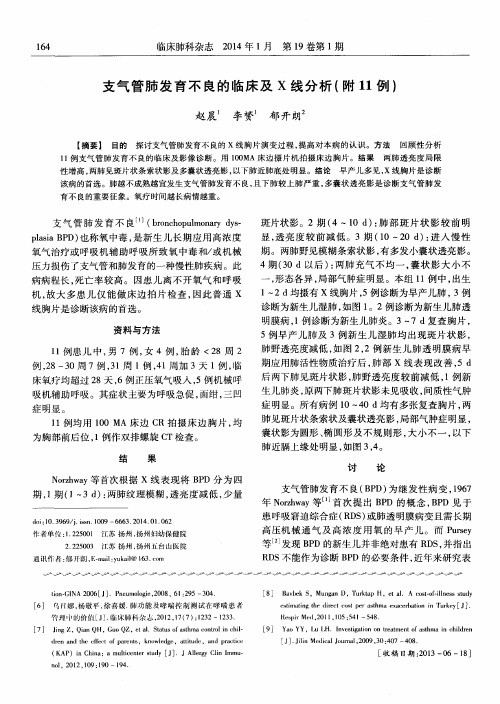
该病的首选。肺越不成熟越宜发生支气管肺发育不 良, 且下肺 较上肺严重 , 多囊状透亮 影是诊断支气 管肺发
支 气 管 肺 发 育 不 良… ( b r o n c h o p u l m o n a r y d y s — p l a s i a B P D) 也称 氧 中毒 , 是 新 生 儿 长期 应 用 高浓 度
氧气 治疗 或呼 吸机 辅 助 呼 吸所 致 氧 中毒 和/ 或 机械
斑 片状 影 。2期 ( 4~1 0 d ) : 肺 部 斑 片 状 影 较 前 明
显, 透 亮 度 较 前 减 低 。3期 ( 1 O一2 0 d ) : 进 入 慢 性 期 。两肺野 见模糊 条索 状影 , 有 多发小囊 状透 亮影 。
, ) 、
、
p
、
、 j 、 ; >、 ’
、 0 、
、
、 ≯
— .
, ; )、 , ; > .
、
0; )
t i o n . G I N A 2 0 0 6 [ J ] .P n e u m o l o g i e , 2 0 0 8 , 6 1 : 2 9 5— 3 0 4 . [ 6] F } 娜, 杨敬平 , 徐喜 媛. 肺功能 及哮喘榨 制测试在 哮喘患 者
症 明显 。
症 明显 。所有 病例 1 0— 4 0 d均 有 多张 复查胸 片 , 两
肺 见斑 片状条 索状 及囊状 透亮 影 , 局 部气 肿症 明显 , 囊 状影 为 圆形 、 椭 圆形及 不 规 则形 , 大 小不 一 , 以下 肺 近膈 上缘处 明显 , 如图 3 , 4 。
作者单位 : 1 . 2 2 5 0 0 1 江苏 扬州 , 扬 州 妇幼 保 健 院 2 . 2 2 5 0 0 3 江苏 扬州 , 扬 州 五台 山 医 院
支气管肺发育不良诊疗要点
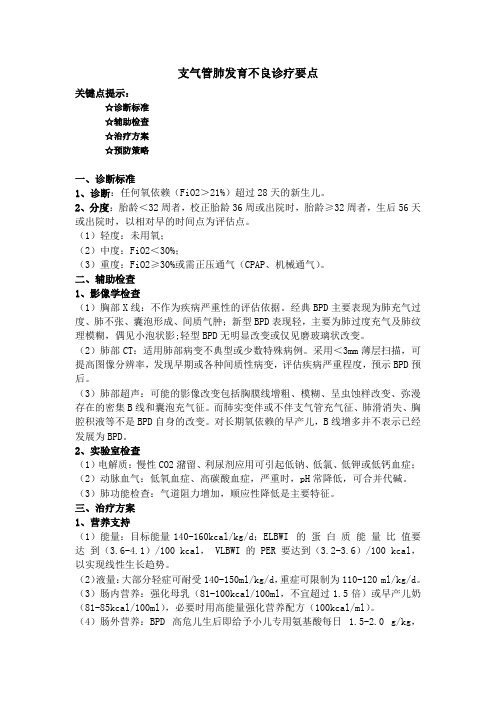
支气管肺发育不良诊疗要点关键点提示:☆诊断标准☆辅助检查☆治疗方案☆预防策略一、诊断标准1、诊断:任何氧依赖(FiO2>21%)超过28天的新生儿。
2、分度:胎龄<32周者,校正胎龄36周或出院时,胎龄≥32周者,生后56天或出院时,以相对早的时间点为评估点。
(1)轻度:未用氧;(2)中度:FiO2<30%;(3)重度:FiO2≥30%或需正压通气(CPAP、机械通气)。
二、辅助检查1、影像学检查(1)胸部X线:不作为疾病严重性的评估依据。
经典BPD主要表现为肺充气过度、肺不张、囊泡形成、间质气肿;新型BPD表现轻,主要为肺过度充气及肺纹理模糊,偶见小泡状影;轻型BPD无明显改变或仅见磨玻璃状改变。
(2)肺部CT:适用肺部病变不典型或少数特殊病例。
采用<3mm薄层扫描,可提高图像分辨率,发现早期或各种间质性病变,评估疾病严重程度,预示BPD预后。
(3)肺部超声:可能的影像改变包括胸膜线增粗、模糊、呈虫蚀样改变、弥漫存在的密集B线和囊泡充气征。
而肺实变伴或不伴支气管充气征、肺滑消失、胸腔积液等不是BPD自身的改变。
对长期氧依赖的早产儿,B线增多并不表示已经发展为BPD。
2、实验室检查(1)电解质:慢性CO2潴留、利尿剂应用可引起低钠、低氯、低钾或低钙血症;(2)动脉血气:低氧血症、高碳酸血症,严重时,pH常降低,可合并代碱。
(3)肺功能检查:气道阻力增加,顺应性降低是主要特征。
三、治疗方案1、营养支持(1)能量:目标能量140-160kcal/kg/d;ELBWI 的蛋白质能量比值要达到(3.6-4.1)/100 kcal, VLBWI 的 PER 要达到(3.2-3.6)/100 kcal,以实现线性生长趋势。
(2)液量:大部分轻症可耐受140-150ml/kg/d,重症可限制为110-120 ml/kg/d。
(3)肠内营养:强化母乳(81-100kcal/100ml,不宜超过1.5倍)或早产儿奶(81-85kcal/100ml),必要时用高能量强化营养配方(100kcal/ml)。
支气管肺发育不良10例临床分析
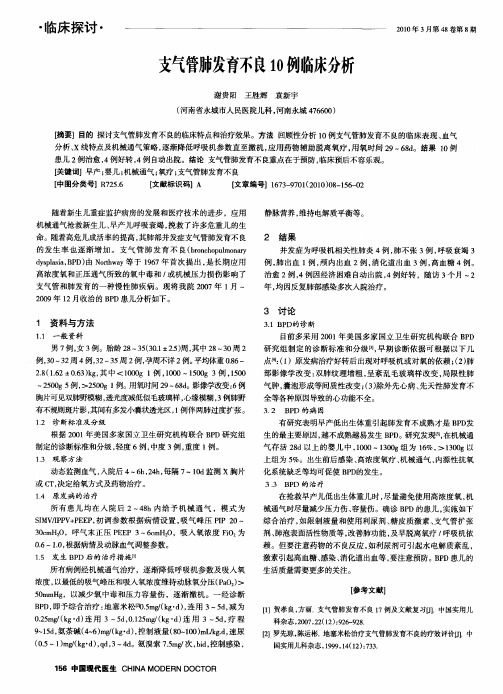
激素引起高血糖 、 感染 、 消化道出血等 , 要注意预防。B D患儿 的 P
生 活质量需要更多的关 注。 【 参考文献】
【 贺孝 良, 1 】 方丽. 支气管肺发育不 良 1 7例及文献复 习[. J 中国实用儿 ]
科杂志 ,0 72 (2 :2 — 2 , 2 0 ,2 1 )9 6 9 8
研 究组制定 的诊断标 准和分级[, 期诊断依 据可根据 以下几 3早 1 点 :1 ( )原发病 治疗好转后出现对呼吸机或对氧 的依赖 ;2 肺 () 部影像 学改变 : 双肺纹 理增 粗 , 呈紊 乱毛玻璃样改变 , 局限性肺 气肿 , 囊泡形成等间质性改变 ;3 除外先心病、 () 先天性肺发育不 全等各种原 因导致 的心功能不全 。
3 2 B D 的病 因 . P
28 1 2± . )g 其 中<10 g l例 ,0 0~10 g 3例 ,50 .(. 06 k , 6 3 00 10 5 0 10
—
20g 例 , 50 例。 50 >20g1 用氧时间 2 ~ 8。 5 9 6d 影像学改变 :例 6
胸片可见双肺野模糊 , 透光度减低似毛玻璃样 , 心缘模糊 , 3例肺野 有不规则斑片影 , 其问有多发小囊状透光区 , 例伴两肺过度扩张。 1
・
临床探讨 ・
21年3 00 月第 4 卷第 8 8 期
支气 肺发育 管 不良1例临 析 0 床分
谢贵 阳 王胜辉 袁新宇
( 河南省永城市人 民医院儿科 , 河南永城 46 0 ) 7 60 【 摘要】目的 探讨支气管肺发育不 良的临床特点和治疗效果 。方法 回顾性分析 1 0例支气 管肺发育不 良的临床表现 、 血气 分析、 x线特点及机械通气策略 , 逐渐降低呼吸机参数直 至撤 机 , 应用药 物辅 助脱 离氧疗 , 用氧时间 2 9~6 d 8 。结果 1 0例 患儿 2 例治愈 , 4例好转 , 自动 出院。结论 支气管肺发育不 良重点在于预防, 4例 临床预后不容乐观 。 【 关键词】早产 ; L机械通气 ; 婴J ; 氧疗 ; 支气管肺发育不良
机械通气后早产儿支气管肺发育不良的临床特点分析
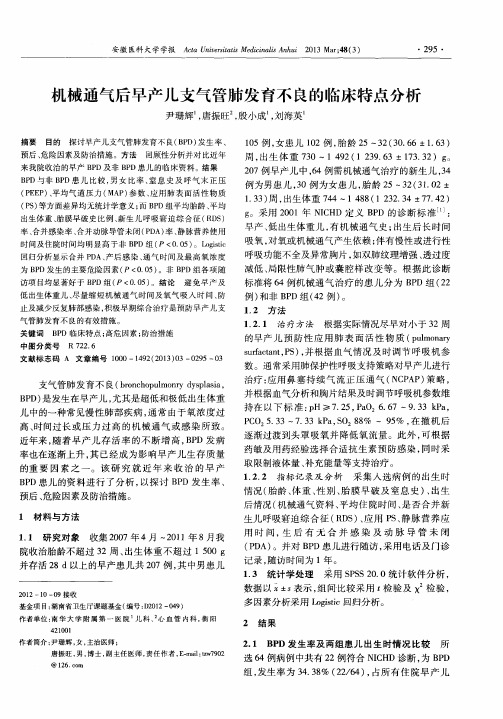
的早产 儿 预 防 性 应 用 肺 表 面 活 性 物 质 ( p u l m o n Nhomakorabeaa r y
文献标志码 A 文章编号 1 0 0 0—1 4 9 2 ( 2 0 1 3 ) 0 3— 0 2 9 5— 0 3
s u r f a c t a n t , P S ) , 并 根 据血 气 情 况 及 时调 节 呼 吸机 参 数 。通 常采 用肺 保 护性 呼吸 支持 策略 对早 产儿 进行 治疗 : 应用鼻塞持续气流 正压通气 ( N C P A P ) 策略 , 并根 据血 气 分析 和胸 片结 果及 时调 节 呼 吸机参 数维 持在以下标 准 : p H≥7 . 2 5 , P a O 2 6 。 6 7~9 . 3 3 k P a ,
安徽 医科大 学学报 A c t a U n i v e r s i t a t i s Me d i c i n a l i s A n h u i 2 0 1 3 M a r ; 4 8 ( 3 )
・2 9 5・
机械通气后早产 儿支气管肺发 育不 良的临床特点 分析
尹 珊辉 , 唐 振 旺 , 殷 小成 , 刘 海英 。
P C O , 5 . 3 3~7 . 3 3 k P a , S O , 8 8 % ~9 5 %, 在 撤 机 后
支 气 管肺 发育 不 良( b r o n c h o p u l mo n r y d y s p l a s i a , B P D ) 是发 生在 早产 儿 , 尤 其是 超低 和 极低 出生体 重 儿 中的一种 常见 慢 性 肺部 疾 病 , 通 常 由于氧 浓 度 过 高、 时 间过 长 或 压 力 过 高 的机 械 通 气 或 感 染 所 致 。 近 年来 , 随 着 早 产 儿 存 活 率 的不 断 增 高 , B P D 发 病 率 也在 逐渐 上升 , 其 已经 成 为 影 响早 产 儿 生 存 质 量 的重 要 因 素 之 一 。该 研 究 就 近 年 来 收 治 的 早 产 B P D患儿 的资 料 进 行 了分 析 , 以探 讨 B P D发生率 、 预后 、 危 险 因素及 防治措施 。
气管性支气管、副膈综合征等肺部发育异常发病机制、好发部位、临床表现、分型、发病率及影像表现
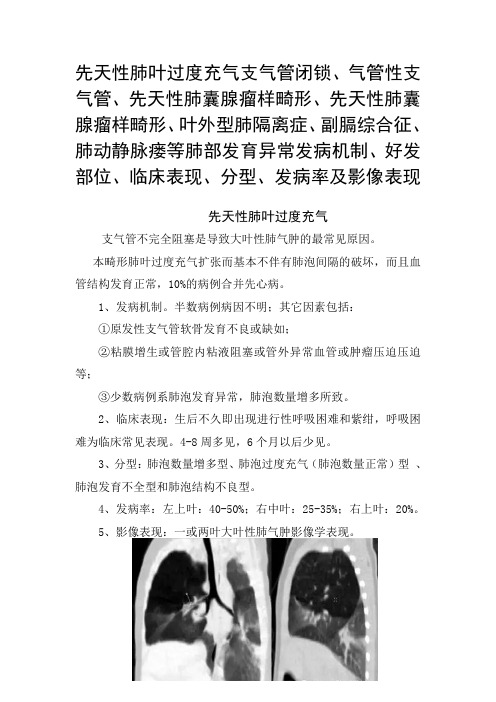
先天性肺叶过度充气支气管闭锁、气管性支气管、先天性肺囊腺瘤样畸形、先天性肺囊腺瘤样畸形、叶外型肺隔离症、副膈综合征、肺动静脉瘘等肺部发育异常发病机制、好发部位、临床表现、分型、发病率及影像表现先天性肺叶过度充气支气管不完全阻塞是导致大叶性肺气肿的最常见原因。
本畸形肺叶过度充气扩张而基本不伴有肺泡间隔的破坏,而且血管结构发育正常,10%的病例合并先心病。
1、发病机制。
半数病例病因不明;其它因素包括:①原发性支气管软骨发育不良或缺如;②粘膜增生或管腔内粘液阻塞或管外异常血管或肿瘤压迫压迫等;③少数病例系肺泡发育异常,肺泡数量增多所致。
2、临床表现:生后不久即出现进行性呼吸困难和紫绀,呼吸困难为临床常见表现。
4-8周多见,6个月以后少见。
3、分型:肺泡数量增多型、肺泡过度充气(肺泡数量正常)型、肺泡发育不全型和肺泡结构不良型。
4、发病率:左上叶:40-50%;右中叶:25-35%;右上叶:20%。
5、影像表现:一或两叶大叶性肺气肿影像学表现。
支气管闭锁支气管闭锁系节段支气管与中央支气管不相通,病因不明。
可与肺隔离症和支气管源性囊肿并存。
大多数患者无临床表现,好发于女性患者(男女之比约1:2),体格检查患侧肺呼吸音减弱,有症状的患者常常表现为肺部反复感染、呼吸困难、哮喘或慢性咳嗽。
本病好发于左上叶尖后段,其次为左下叶、右中叶。
典型影像表现:分枝的管状团块,周围肺透亮度增高,血管纹理减少。
当肿块呈线条状及周围肺透亮度增高不明显时,容易误诊为动静脉畸形、肉芽肿或转移瘤。
气管性支气管气管性支气管是支气管起源于气管隆突上气管壁的一种先天性畸形。
气管性支气管起源于气管的右肺上叶支气管。
该畸形常常伴有气道的其他异常,在儿童可能出现喘息、反复肺炎、气管插管并发症等。
气管性支气管通常为单侧性,多起自气管隆突上方气管右侧壁,分布到右肺上叶尖段或整个上叶。
起自气管左侧壁及双侧发生的气管性支气管少见。
不同胚胎时期的异常胚芽样隆起决定了异位支气管的位置。
- 1、下载文档前请自行甄别文档内容的完整性,平台不提供额外的编辑、内容补充、找答案等附加服务。
- 2、"仅部分预览"的文档,不可在线预览部分如存在完整性等问题,可反馈申请退款(可完整预览的文档不适用该条件!)。
- 3、如文档侵犯您的权益,请联系客服反馈,我们会尽快为您处理(人工客服工作时间:9:00-18:30)。
doi: 10.7499/j.issn.1008-8830.2015.05.005论著·临床研究不同程度支气管肺发育不良早产儿的临床及影像学特点任艳丽1,2 孔祥永1 杜志方3 封志纯1 黄俊谨1 陈佳1 张珊1(1.南方医科大学北京军区总医院临床医学院附属八一儿童医院,北京 100007;2.福建医科大学教学医院福建省妇幼保健院新生儿科,福建 福州 350001;3.中国人民解放军白求恩国际和平医院儿科,河北 石家庄 050082)[摘要] 目的 探讨不同程度支气管肺发育不良(BPD)早产儿的临床及影像学特点。
方法 对59例胎龄<32周BPD 早产儿的临床及影像学特点进行前瞻性研究。
59例早产儿中包括轻度BPD 37例,中/重度BPD 22例,比较不同程度BPD患儿的临床及影像学表现。
结果 中/重度BPD组患儿机械通气、氧疗、抗生素、静脉营养等应用时间及住院时间长于轻度BPD组(P<0.05),院内感染发生率、红细胞输注次数高于轻度BPD 组(P<0.05)。
轻度BPD组呼吸窘迫综合征(RDS)Ⅰ级(生后1 d)、肺透亮度减低(生后4~10 d、生后28 d 及以上)等X线改变比例较中/重度BPD组高(P<0.05);中/重度BPD组BPD Ⅲ期改变(生后4~10 d)、BPD Ⅳ期改变(生后28 d及以上)等比例较轻度BPD组高(P<0.05)。
结论 呼吸机、氧疗、抗生素等应用时间及院内感染发生率与BPD严重程度相关。
BPD程度越重的患儿,静脉营养时间越长,输注红细胞次数越多,BPD影像学改变更典型。
BPD影像学检查对BPD的严重程度有一定的预测作用。
[中国当代儿科杂志,2015,17(5):440-444][关键词] 支气管肺发育不良;胸部X线检查;胸部CT扫描;新生儿Clinical and imaging features of premature infants with different degrees of bronchopulmonary dysplasiaREN Yan-Li, KONG Xiang-Yong, DU Zhi-Fang, FENG Zhi-Chun, HUANG Jun-Jin, CHEN Jia, ZHANG Shan. Bayi Children's Hospital Affiliated to Clinical Medical College in Beijing Military General Hospital of Southern Medical University, Beijing 100007, China (Feng Z-C, Email: zhjfengzc@)Abstract: Objective To study the clinical and imaging features of premature infants with different degrees of bronchopulmonary dysplasia (BPD).Methods A prospective study was performed on the clinical data of 59 premature infants (gestational age <32 weeks) with BPD. Among the 59 premature infants, 37 cases had mild BPD and the other22 cases had moderate to severe BPD. The clinical and imaging data were compared between these premature infantswith different degrees of BPD.Results The durations of mechanical ventilation, oxygen therapy, antibiotic therapy, parenteral nutrition, and hospitalization in the moderate to severe group were significantly longer than those in the mild group (P<0.05). The incidence of nosocomial infection and number of times of red blood cell transfusion in the moderate to severe group were significantly higher than that in the mild group. The rates of X-ray changes, including grade I respiratory distress syndrome (1 day after birth) and hypolucency of lungs (4-10 days and ≥28 days after birth) were significantly higher in the mild group than in the moderate to severe group. The rates of X-ray changes in classical BPD stage III (4-10 days after birth) and IV (≥28 days after birth) were significantly higher in the moderate to severe group than in the mild group. Conclusions The durations of mechanical ventilation, oxygen therapy, and antibiotic therapy and the incidence of nosocomial infection are correlated with the severity of BPD. The premature infants with severer BPD need a longer duration of parenteral nutrition and more times of red blood cell transfusion and have more typical imaging changes of BPD. Imaging examination has a predictive value for the severity of BPD.[Chin J Contemp Pediatr, 2015, 17(5): 440-444] Key words:Bronchopulmonary dysplasia; Chest X-ray; Chest CT scan; Neonate[收稿日期]2014-12-10;[接受日期]2015-01-28[作者简介]任艳丽,女,博士研究生,主治医师。
[通信作者]封志纯,男,主任医师。
早产儿支气管肺发育不良(bronchopulmonary dysplasia, BPD)是严重威胁早产儿存活及预后的疾病之一。
BPD患儿存活者由于肺功能受损,住院时间长,再次入院率高[1];可伴有神经系统发育受损,对存活早产儿的生存质量影响巨大[2]。
随着围产技术和新生儿重症技术的日益发展,早产儿尤其是超低、极低出生体重儿的出生率及存活率逐年上升,早产儿BPD的发生率亦呈上升趋势。
然而目前该病尚缺乏有效的治疗方法[3]。
为了早期辨识BPD发生的几率及严重程度,为预防BPD 的发生及临床诊治提供依据,了解不同严重程度BPD的临床表现及影像学特点显得尤为重要。
本研究通过对不同严重程度BPD患儿的临床及影像学表现进行分析,以期为该病的临床诊治提供依据。
1 资料与方法1.1 研究对象从2013年11月至2014年5月入住北京军区总医院八一儿童医院极早产病房胎龄<32周且确诊为BPD的新生儿中,纳入入院日龄≤24 h且有进行胸部CT检查的患儿作为研究对象。
患有复杂性先天性心脏病、染色体异常者被排除。
共有59例患儿纳入本研究,其中男44例,女15例;胎龄25.6~31.7周,平均28.6±1.3周;出生体重740~1 600 g,平均1 191±218 g,包括极低出生体重儿52例,超低出生体重儿13例。
59例患儿按病情严重程度分为:轻度组(n=37)及中/重度组(n=22)。
1.2 BPD诊断及分度标准BPD诊断及分度标准参照文献[4]。
任何氧依赖(FiO2>21%)超过28 d的新生儿即诊断为BPD。
如胎龄<32周,根据校正胎龄36周或出院时需要的吸入氧浓度(FiO2)分度:(1)轻度:未用氧;(2)中度:FiO2<30%;(3)重度:FiO2≥30%或需机械通气。
1.3 经典型BPD影像学改变分期标准据Northway等[5]报道,BPD患儿 X线胸片有特征性改变,即Ⅰ期(1~3 d):双肺野呈磨玻璃状改变,与呼吸窘迫综合征(RDS)的X线改变相同;Ⅱ期(4~10 d):双肺完全不透明;Ⅲ期(11~30 d):双肺野密度不均,可见线条状或斑片状阴影间伴充气的透亮小囊腔;Ⅳ期(1个月后):双肺野透亮区扩大呈囊泡状,伴两肺结构紊乱、有散在条状或斑片影以及充气过度和肺不张。
1.4 新生儿RDS影像学分级标准新生儿RDS影像学分级标准参照文献[6]。
Ⅰ级:两肺野普遍透亮度减低,可见均匀散在的细小颗粒和网状阴影;Ⅱ级:Ⅰ级改变加重伴支气管充气征;Ⅲ级:肺野透亮度更低,心缘及膈面模糊;Ⅳ级:肺野呈白肺。
1.5 胸部影像学检查时间胸部X线检查时间为:出生后1 d、4~10 d、11~27 d、28 d以上。
确诊为BPD的患儿均进行胸部CT检查,住院期间胸部CT检查仅执行1次,检查时间为停氧后7 d内进行。
因目前认为不同类型BPD在影像学表现上大致相似[4,7],故仍然沿用经典型BPD的描述对所有BPD影像进行分析。
1.6 资料收集记录患儿胎龄、性别、出生体重、最高吸氧浓度、有创通气时间、无创通气时间、氧疗时间、抗生素使用时间、静脉营养使用时间、红细胞输注次数、住院时间、影像学检查结果及院内感染、肺出血、症状性动脉导管未闭(PDA)、坏死性小肠结肠炎(NEC)、早产儿视网膜病变(ROP)、巨细胞病毒(CMV)感染、脑室内出血(IVH)Ⅲ级等发生情况。
